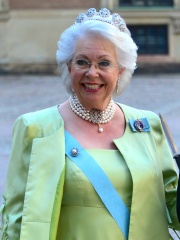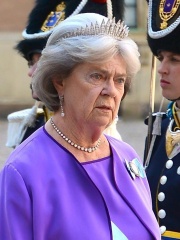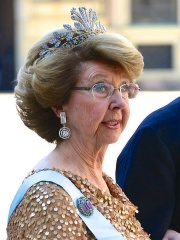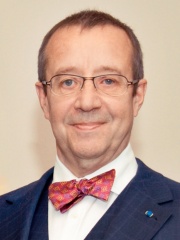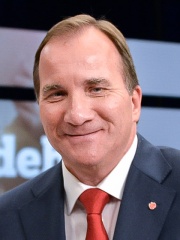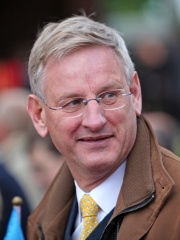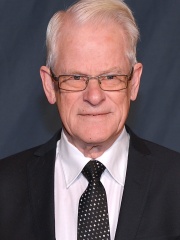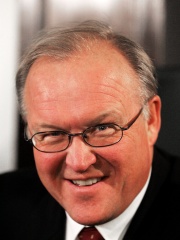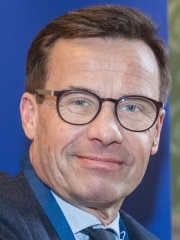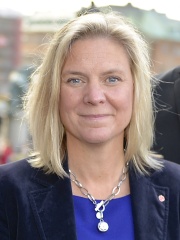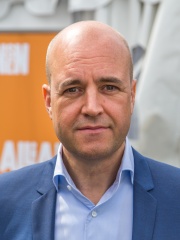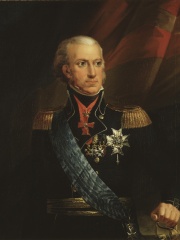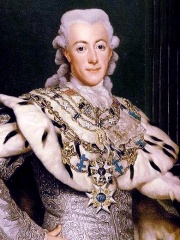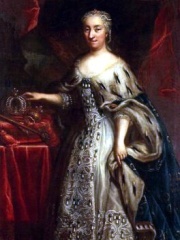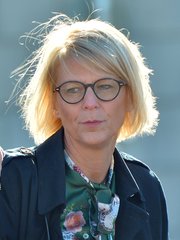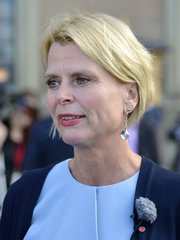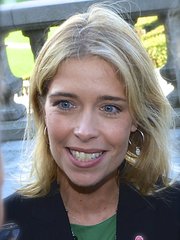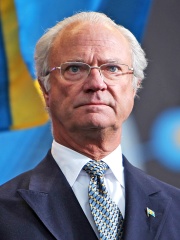
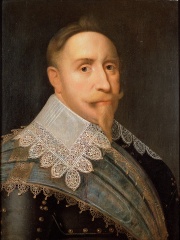
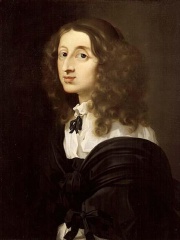
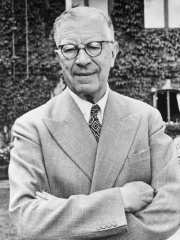
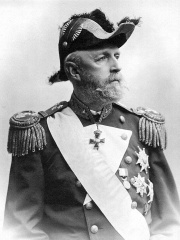
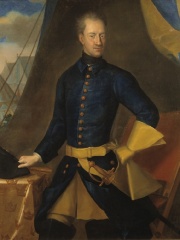
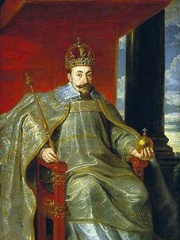
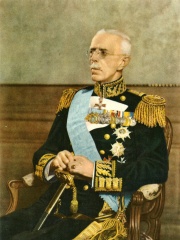
The Most Famous
POLITICIANS from Sweden
This page contains a list of the greatest Swedish Politicians. The pantheon dataset contains 19,576 Politicians, 196 of which were born in Sweden. This makes Sweden the birth place of the 18th most number of Politicians behind Egypt, and Iraq.
Top 10
The following people are considered by Pantheon to be the top 10 most legendary Swedish Politicians of all time. This list of famous Swedish Politicians is sorted by HPI (Historical Popularity Index), a metric that aggregates information on a biography's online popularity. Visit the rankings page to view the entire list of Swedish Politicians.

1. Carl XVI Gustaf of Sweden (b. 1946)
With an HPI of 84.47, Carl XVI Gustaf of Sweden is the most famous Swedish Politician. His biography has been translated into 90 different languages on wikipedia.
Carl XVI Gustaf (Carl Gustaf Folke Hubertus; born 30 April 1946) is King of Sweden, reigning since 1973. Having reigned for 52 years, he is the longest-reigning monarch in Swedish history. Carl Gustaf was born during the reign of his paternal great-grandfather, King Gustaf V, as the youngest child and only son of Prince Gustaf Adolf, Duke of Västerbotten, and Princess Sibylla of Saxe-Coburg and Gotha. His father died in an airplane crash in Denmark in January 1947, when Carl Gustaf was nine months old. Carl Gustaf became crown prince and heir apparent to the Swedish throne at the age of four when his grandfather Gustaf VI Adolf acceded to the throne in 1950. Carl Gustaf acceded to the throne upon his grandfather's death on 15 September 1973. Shortly after he became king, the new 1974 Instrument of Government took effect, formally stripping the monarchy of its remaining executive powers. As a result, Carl Gustaf no longer performs many of the duties normally accorded to a head of state in parliamentary regimes, such as the formal appointment of the prime minister, signing legislation into law, and being commander-in-chief of the nation's military. The new instrument explicitly limited the king to ceremonial and representative functions, while he retained the right to be regularly informed of affairs of state. As head of the House of Bernadotte, Carl Gustaf has also been able to make a number of decisions about the titles and positions of its members. In June 1976, Carl Gustaf married Silvia Sommerlath. They have three children: Victoria, Carl Philip, and Madeleine. The king's heir apparent, after passage on 1 January 1980 of a new law establishing absolute primogeniture, is his eldest child, Crown Princess Victoria. Victoria's younger brother, Carl Philip, was briefly the heir apparent from his birth in May 1979 until the application of said law.

2. Gustavus Adolphus of Sweden (1594 - 1632)
With an HPI of 83.70, Gustavus Adolphus of Sweden is the 2nd most famous Swedish Politician. His biography has been translated into 75 different languages.
Gustavus Adolphus (9 December [N.S 19 December] 1594 – 6 November [N.S 16 November] 1632), also known in English as Gustav II Adolf or Gustav II Adolph, was King of Sweden from 1611 to 1632. He is credited with the rise of Sweden as a great European power (Swedish: Stormaktstiden). During his reign, Sweden became one of the primary military forces in Europe during the Thirty Years' War, helping to determine the political and religious balance of power in Europe. He was formally and posthumously given the name Gustavus Adolphus the Great (Swedish: Gustav Adolf den store; Latin: Gustavus Adolphus Magnus) by the Riksdag of the Estates in 1634. He is often regarded as one of the greatest military commanders in modern history, with use of an early form of combined arms. His most notable military victory was the Battle of Breitenfeld in 1631. With his resources, logistics, and support, Gustavus Adolphus was positioned to become a major European leader, but he was killed a year later at the Battle of Lützen. He was assisted in his efforts by Count Axel Oxenstierna, the Lord High Chancellor of Sweden, who also acted as regent after his death. Coming to the throne at the age of 16, Gustavus Adolphus inherited three wars from his father Charles IX of Sweden: border conflicts with Russia and Denmark–Norway, and a dynastic struggle with his first cousin, King Sigismund III Vasa of Poland. Of these, the Danish war was the most serious. During his reign, Sweden rose from the status of a Baltic Sea basin regional power to one of the great powers of Europe and a model of early modern era government. Gustavus Adolphus is known as the "father of modern warfare", or the first modern general. Gustavus Adolphus was the main figure responsible for the success of Swedish arms during the Thirty Years' War and led his nation to great prestige. As a general, Gustavus Adolphus employed mobile artillery on the battlefield, as well as very aggressive tactics, where attack was stressed over defense, and mobility and cavalry initiative were emphasized. He taught a number of other military commanders, such as Lennart Torstensson, who would go on to expand the boundaries and power of the Swedish Empire after Gustavus Adolphus's death. Spoils meant he became a successful bookraider in Europe, targeting Jesuit library collections. His contributions to Sweden's rise in power included reformation of the administrative structure. For example, he began Parish Registration of the population, so that the central government could more efficiently tax and conscript the people. He is also widely commemorated by Protestants in Europe as the main defender of their cause during the Thirty Years' War, with multiple churches, foundations and other undertakings named after him, including the Gustav-Adolf-Werk. His involvement in the Thirty Years' War gave rise to the nickname "the Lion from the North".

3. Christina, Queen of Sweden (1626 - 1689)
With an HPI of 83.60, Christina, Queen of Sweden is the 3rd most famous Swedish Politician. Her biography has been translated into 67 different languages.
Christina (Swedish: Kristina; 18 December [O.S. 8 December] 1626 – 19 April 1689), a member of the House of Vasa, was Queen of Sweden from 1632 until her abdication in 1654. Her conversion to Catholicism and refusal to marry led her to relinquish her throne and move to Rome. Christina is remembered as one of the most erudite women of the 17th century, wanting Stockholm to become the "Athens of the North" and was given the special right to establish a university at will by the Peace of Westphalia. She is also remembered for her unconventional lifestyle and occasional adoption of masculine attire, which have been depicted frequently in media; gender and cultural identity are pivotal themes in many of her biographies. At the age of five, Christina succeeded her father Gustavus Adolphus upon his death at the Battle of Lützen, though she only began ruling the Swedish Empire when she reached the age of eighteen. During the Torstenson War in 1644, she initiated the issuance of copper in lumps to be used as currency. Her lavish spending habits pushed the state towards bankruptcy, sparking public unrest. Christina argued for peace to end the Thirty Years' War and received indemnity. Following scandals over her converting to Catholicism, and not marrying, she relinquished the throne to her cousin Charles X Gustav and settled in Rome. Pope Alexander VII described Christina as "a queen without a realm, a Christian without faith, and a woman without shame." She played a leading part in the theatrical and musical communities and protected many Baroque artists, composers, and musicians. Christina, who was the guest of five consecutive popes and a symbol of the Counter-Reformation, is one of the few women buried in the Vatican Grottoes.

4. Gustaf VI Adolf of Sweden (1882 - 1973)
With an HPI of 80.48, Gustaf VI Adolf of Sweden is the 4th most famous Swedish Politician. His biography has been translated into 62 different languages.
Gustaf VI Adolf (Oscar Fredrik Wilhelm Olaf Gustaf Adolf; 11 November 1882 – 15 September 1973) was King of Sweden from 29 October 1950 until his death in 1973. He was the eldest son of Gustaf V and his wife, Victoria of Baden. Before Gustaf Adolf acceded to the throne, he was crown prince for nearly 43 years during his father's reign. As king, and shortly before his death, he gave his approval to constitutional changes which removed the Swedish monarchy's last political powers. He was a lifelong amateur archeologist particularly interested in Ancient Italian cultures.
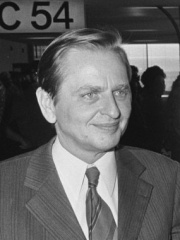
5. Olof Palme (1927 - 1986)
With an HPI of 80.20, Olof Palme is the 5th most famous Swedish Politician. His biography has been translated into 79 different languages.
Sven Olof Joachim Palme (; Swedish: [ˈûːlɔf ˈpâlːmɛ] ; 30 January 1927 – 28 February 1986) was a Swedish politician and statesman who served as Prime Minister of Sweden from 1969 to 1976 and 1982 to 1986. Palme led the Swedish Social Democratic Party from 1969 until his assassination in 1986. A longtime protégé of Prime Minister Tage Erlander, he became Prime Minister of Sweden and Chairman of the Social Democratic Party in 1969. He left office after failing to form a government after the 1976 general election, which ended 40 years of unbroken rule by the Social Democratic Party. While he served as a Leader of the Opposition, he also served as special mediator of the United Nations in the Iran–Iraq War, and was President of the Nordic Council in 1979. He faced a second defeat in 1979, but he returned as prime minister after electoral victories in 1982 and 1985, and served until his death. Palme was a pivotal and polarizing figure domestically as well as in international politics from the 1960s onward. He was steadfast in his non-alignment policy towards the superpowers, accompanied by support for numerous liberation movements following decolonization including, most controversially, economic and vocal support for a number of Third World governments. He was the first Western head of government to visit Cuba after its revolution, giving a speech in Santiago praising contemporary Cuban revolutionaries. Frequently a critic of Soviet and American foreign policy, he expressed his resistance to imperialist ambitions and authoritarian regimes, including those of Francisco Franco of Spain, Augusto Pinochet of Chile, Leonid Brezhnev of the Soviet Union, António de Oliveira Salazar of Portugal, Gustáv Husák of Czechoslovakia, and most notably John Vorster and P. W. Botha of South Africa, denouncing apartheid as a "particularly gruesome system". His 1972 condemnation of American bombings in Hanoi, comparing the bombings to a number of historical crimes including the bombing of Guernica, the massacres of Oradour-sur-glane, Babi Yar, Katyn, Lidice and Sharpeville and the extermination of Jews and other groups at Treblinka, resulted in a temporary freeze in Sweden–United States relations. Palme's assassination on a Stockholm street on 28 February 1986 was the first murder of a national leader in Sweden since Gustav III in 1792, and had a great impact across Scandinavia. Local convict and addict Christer Pettersson was originally convicted of the murder in Stockholm District Court but was unanimously acquitted by the Svea Court of Appeal. On 10 June 2020, Swedish prosecutors held a press conference to announce that there was "reasonable evidence" that Stig Engström had killed Palme. As Engström had killed himself in 2000, the authorities announced that the investigation into Palme's death was to be closed. The 2020 conclusion has faced widespread criticism from lawyers, police officers and journalists, decrying the evidence as only circumstantial, and – by the prosecutors' own admission – too weak to ensure a trial had the suspect been alive. The true identity of his assassin remains unknown.

6. Oscar II of Sweden (1829 - 1907)
With an HPI of 80.12, Oscar II of Sweden is the 6th most famous Swedish Politician. His biography has been translated into 62 different languages.
Oscar II (Oscar Fredrik; 21 January 1829 – 8 December 1907) was King of Sweden from 1872 until his death in 1907 and King of Norway from 1872 to 1905. Oscar was the son of King Oscar I and Queen Josephine. He inherited the Swedish and Norwegian thrones when his brother died in 1872. Oscar II ruled during a time when both countries were undergoing a period of industrialization and rapid technological progress. His reign also saw the gradual decline of the Union of Sweden and Norway, which culminated in its dissolution in 1905. In 1905, the throne of Norway was transferred to his grandnephew Prince Carl of Denmark under the regnal name Haakon VII. When Oscar died in 1907, he was succeeded in Sweden by his eldest son, Gustaf V.

7. Charles XII of Sweden (1682 - 1718)
With an HPI of 79.79, Charles XII of Sweden is the 7th most famous Swedish Politician. His biography has been translated into 72 different languages.
Charles XII, sometimes Carl XII (Swedish: Karl XII) or Carolus Rex (17 June 1682 – 30 November 1718 O.S.), was King of Sweden from 1697 to 1718. He belonged to the House of Palatinate-Zweibrücken, a branch line of the House of Wittelsbach. Charles was the only surviving son of Charles XI and Ulrika Eleonora the Elder. He assumed power, after a seven-month caretaker government, at the age of fifteen. In 1700, a triple alliance of Denmark–Norway, Saxony–Poland–Lithuania and Russia launched a threefold attack on the Swedish protectorate of Holstein-Gottorp and provinces of Livonia and Ingria, aiming to take advantage of the Swedish Empire being unaligned and ruled by a young and inexperienced king, thus initiating the Great Northern War. Leading the Swedish army against the alliance, Charles won multiple victories despite being significantly outnumbered. A major victory over a much larger Russian army in 1700, at the Battle of Narva, compelled Peter the Great to sue for peace, an offer that Charles subsequently rejected. By 1706, Charles, now 24 years old, had forced all of his foes into submission. That year, Swedish forces under general Carl Gustav Rehnskiöld won a decisive victory over a combined army of Saxony and Russia at the Battle of Fraustadt. Russia was now the sole remaining hostile power. Charles's subsequent march on Moscow met with initial success as victory followed victory, the most significant of which was the Battle of Holowczyn where the smaller Swedish army routed a Russian army twice its size. The campaign ended with disaster when the Swedish army suffered heavy losses to a Russian force more than twice its size at Poltava. Charles had been incapacitated by a wound prior to the battle, rendering him unable to take command. The defeat was followed by the Surrender at Perevolochna. Charles spent the following years in exile in the Ottoman Empire before returning to lead an assault on Norway, trying to evict the Danish king from the war once more in order to aim all his forces at the Russians. Two campaigns met with frustration and ultimate failure, concluding with his death at the Siege of Fredriksten in 1718. At the time, most of the Swedish Empire was under foreign military occupation, though Sweden itself was still free. This situation was later formalized, albeit moderated in the subsequent Treaty of Nystad. The result was the end of the Swedish Empire, and also of its effectively organized absolute monarchy and war machine, commencing a parliamentary government unique for continental Europe, which would last for half a century until royal autocracy was restored by Gustav III. Charles was an exceptionally skilled military leader and tactician as well as an able politician, credited with introducing important tax and legal reforms. As for his famous reluctance towards peace efforts, he is quoted by Voltaire as saying upon the outbreak of the war: "I have resolved never to start an unjust war but never to end a legitimate one except by defeating my enemies". With the war consuming more than half his life and nearly all his reign, he never married and fathered no children. He was succeeded by his sister Ulrika Eleonora, who in turn was coerced to hand over all substantial powers to the Riksdag of the Estates and opted to surrender the throne to her husband Friedrich of Hesse-Kassel, who became King Frederick I of Sweden.

8. Sigismund III Vasa (1566 - 1632)
With an HPI of 79.24, Sigismund III Vasa is the 8th most famous Swedish Politician. His biography has been translated into 66 different languages.
Sigismund III Vasa (Polish: Zygmunt III Waza, Lithuanian: Žygimantas Vaza; 20 June 1566 – 30 April 1632 N.S.) was King of Poland and Grand Duke of Lithuania from 1587 to 1632 and, as Sigismund, King of Sweden from 1592 to 1599. He was the first Polish sovereign from the House of Vasa. Religiously zealous, he imposed Catholicism across the vast realm, and his crusades against neighbouring states marked Poland's largest territorial expansion. As an enlightened despot, he presided over an era of prosperity and achievement, further distinguished by the transfer of the country's capital from Kraków to Warsaw. Sigismund was the son of King John III of Sweden and his first wife, Catherine Jagiellon, daughter of King Sigismund I of Poland. Elected monarch of the Polish–Lithuanian Commonwealth in 1587, he sought to unify Poland and Sweden under one Catholic kingdom, and when he succeeded his deceased father in 1592 the Polish–Swedish union was created. Opposition in Protestant Sweden caused a war against Sigismund headed by Sigismund's uncle Charles IX, who deposed him in 1599. Sigismund attempted to hold absolute power in all his dominions and frequently undermined parliament. He suppressed internal opposition, strengthened Catholic influence and granted privileges to the Jesuits, whom he employed as advisors and spies during the Counter-Reformation. He actively interfered in the affairs of neighbouring countries; his successful invasion of Russia during the Time of Troubles resulted in the seizure of Smolensk and occupation of Moscow, resulting in Poland's historical greatest territorial extent. Sigismund's army also defeated the Ottoman forces in southeastern Europe, which hastened the downfall of Sultan Osman II. However, the Polish–Swedish conflict had a less favourable outcome. After a series of skirmishes ending in a truce, King Gustavus Adolphus of Sweden launched a campaign against the Commonwealth and annexed parts of Polish Livonia. Sigismund to this day remains a controversial figure in Poland. He is one of the country's most recognisable monarchs. His long reign partially coincided with the Polish Golden Age, the apex in the prestige, power and economic influence of the Polish–Lithuanian Commonwealth. On the other hand, it was also during his rule that the seeds of decline surfaced. Considerable contributions to the arts and architecture as well as military victories were tarnished by intrigues and religious persecutions. He was commemorated in Warsaw by Sigismund's Column, one of the city's chief landmarks and the first secular monument in the form of a column in modern history. It was commissioned after Sigismund's death by his son and successor, Władysław IV.

9. Gustaf V of Sweden (1858 - 1950)
With an HPI of 78.86, Gustaf V of Sweden is the 9th most famous Swedish Politician. His biography has been translated into 63 different languages.
Gustaf V (Oscar Gustaf Adolf; 16 June 1858 – 29 October 1950) was King of Sweden from 8 December 1907 until his death in 1950. He was the eldest son of King Oscar II of Sweden and Sophia of Nassau, a half-sister of Adolphe, Grand Duke of Luxembourg. Reigning from the death of his father Oscar II in 1907 to his own death nearly 43 years later, he holds the record of being the oldest monarch of Sweden with the third-longest reign after Magnus IV (1319–1364) and his own great-grandson, Carl XVI Gustaf (1973–present). He was also the last Swedish monarch to exercise his royal prerogatives, which largely died with him, although they were formally abolished only with the remaking of the Swedish constitution in 1974. He was the first Swedish king since the High Middle Ages not to have a coronation and so never wore the king's crown, a practice that has continued ever since. Gustaf's early reign saw the rise of parliamentary rule in Sweden although the leadup to World War I induced his dismissal of Liberal Prime Minister Karl Staaff in 1914, replacing him with his own figurehead, Hjalmar Hammarskjöld, the father of Dag Hammarskjöld, for most of the war. However, after the Liberals and Social Democrats secured a parliamentary majority under Staaff's successor, Nils Edén, he allowed Edén to form a new government which de facto stripped the monarchy of virtually all powers and enacted universal and equal suffrage, including for women, by 1919. Bowing to the principles of parliamentary democracy, he remained a popular figurehead for the remaining 31 years of his rule, although not completely without influence. Gustaf V had pro-German and anti-Communist stances which were outwardly expressed during World War I and the Russian Civil War. During World War II, he allegedly urged Per Albin Hansson's coalition government to accept requests from Nazi Germany for logistics support, arguing that refusing might provoke an invasion. His intervention remains controversial. An avid hunter and sportsman, Gustaf presided over the 1912 Olympic Games and chaired the Swedish Association of Sports from 1897 to 1907. Most notably, he represented Sweden (under the alias of Mr G.) as a competitive tennis player, keeping up competitive tennis until his eighties, when his eyesight deteriorated rapidly. He was succeeded by his son, Gustaf VI Adolf.
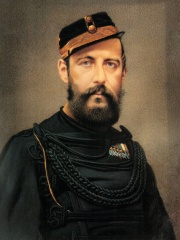
10. Charles XV of Sweden (1826 - 1872)
With an HPI of 78.39, Charles XV of Sweden is the 10th most famous Swedish Politician. His biography has been translated into 61 different languages.
Charles XV and IV (Carl Ludvig Eugen; Swedish and Norwegian officially: Karl; 3 May 1826 – 18 September 1872) was King of Sweden and King of Norway, there often referred to as Charles IV, from 8 July 1859 until his death in 1872. Charles was the third Swedish monarch from the House of Bernadotte. He was the first one to be born in Sweden, the first to grow up speaking Swedish as his first language, and the first to be raised from birth in the Lutheran faith.
People
Pantheon has 209 people classified as Swedish politicians born between 400 and 1998. Of these 209, 82 (39.23%) of them are still alive today. The most famous living Swedish politicians include Carl XVI Gustaf of Sweden, Princess Christina, Mrs. Magnuson, and Princess Margaretha, Mrs. Ambler. The most famous deceased Swedish politicians include Gustavus Adolphus of Sweden, Christina, Queen of Sweden, and Gustaf VI Adolf of Sweden. As of April 2024, 19 new Swedish politicians have been added to Pantheon including Jessika Roswall, Elisabeth Svantesson, and Maria Malmer Stenergard.
Living Swedish Politicians
Go to all RankingsCarl XVI Gustaf of Sweden
1946 - Present
HPI: 84.47
Princess Christina, Mrs. Magnuson
1943 - Present
HPI: 70.16
Princess Margaretha, Mrs. Ambler
1934 - Present
HPI: 70.01
Princess Désirée, Baroness Silfverschiöld
1938 - Present
HPI: 69.39
Toomas Hendrik Ilves
1953 - Present
HPI: 69.38
Stefan Löfven
1957 - Present
HPI: 67.24
Carl Bildt
1949 - Present
HPI: 66.80
Ingvar Carlsson
1934 - Present
HPI: 66.45
Göran Persson
1949 - Present
HPI: 65.99
Ulf Kristersson
1963 - Present
HPI: 65.82
Magdalena Andersson
1967 - Present
HPI: 63.46
Fredrik Reinfeldt
1965 - Present
HPI: 62.73
Deceased Swedish Politicians
Go to all RankingsGustavus Adolphus of Sweden
1594 - 1632
HPI: 83.70
Christina, Queen of Sweden
1626 - 1689
HPI: 83.60
Gustaf VI Adolf of Sweden
1882 - 1973
HPI: 80.48
Olof Palme
1927 - 1986
HPI: 80.20
Oscar II of Sweden
1829 - 1907
HPI: 80.12
Charles XII of Sweden
1682 - 1718
HPI: 79.79
Sigismund III Vasa
1566 - 1632
HPI: 79.24
Gustaf V of Sweden
1858 - 1950
HPI: 78.86
Charles XV of Sweden
1826 - 1872
HPI: 78.39
Charles XIII of Sweden
1748 - 1818
HPI: 78.19
Gustav III of Sweden
1746 - 1792
HPI: 77.58
Ulrika Eleonora, Queen of Sweden
1688 - 1741
HPI: 77.14
Newly Added Swedish Politicians (2025)
Go to all RankingsJessika Roswall
1972 - Present
HPI: 48.11
Elisabeth Svantesson
1967 - Present
HPI: 44.37
Maria Malmer Stenergard
1981 - Present
HPI: 42.87
Åsa Regnér
1964 - Present
HPI: 42.13
Annika Strandhäll
1975 - Present
HPI: 40.42
Filip Forsberg
1994 - Present
HPI: 40.03
Dick Axelsson
1987 - Present
HPI: 37.39
Linnea Torstensson
1983 - Present
HPI: 37.23
Nicklas Danielsson
1984 - Present
HPI: 37.19
Jonas Brodin
1993 - Present
HPI: 36.50
Åsa Westlund
1976 - Present
HPI: 36.50
Felix Rosenqvist
1991 - Present
HPI: 35.66
Overlapping Lives
Which Politicians were alive at the same time? This visualization shows the lifespans of the 25 most globally memorable Politicians since 1700.

